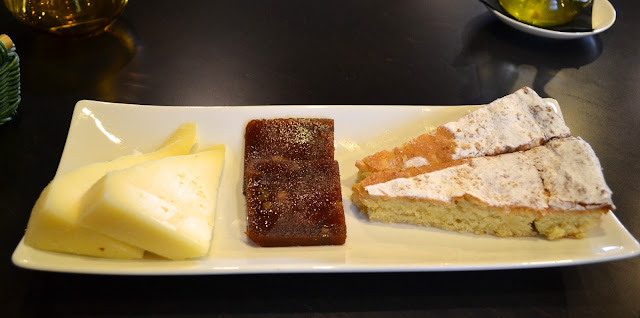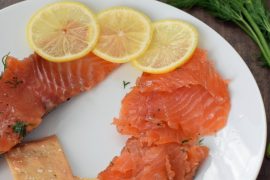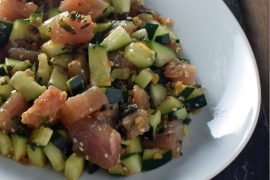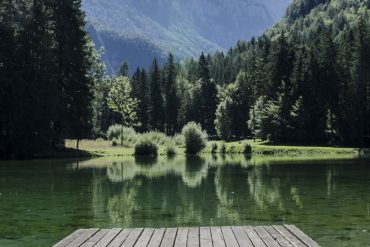 |
| Polbo a Feira, Galicia’s signature dish of octopus with extra virgin olive oil and smoked paprika |
This is the eighth and final installment of our travel series on Northern Spain.
The seaside region of Galicia, in the Northwest corner of Spain, is best known for the pilgrimage city of Santiago de Compostela. For over a thousand years, pilgrims have made the trek from across the Pyrenees in France along the camino de santiago, arriving weary yet exalted at the mystical cathedral in Santiago’s main square. Today, the tradition is as alive as ever, with many (if not most) pilgrims undertaking the long hike for purely secular reasons.
 |
| Pilgrims heading for Santiago’s main square |
We sat for hours watching them arrive, packs and walking sticks in tow. At their first glimpse of the cathedral, a spectacle ensued: some pilgrims burst into applause while others burst into tears; some kissed the ground while others hugged and kissed their friends and loved ones. Still others simply lay there, heads propped up on their packs and eyes gazing toward the cathedral, pondering life and the journeys—physical and otherwise—that had led them to Santiago’s square. We could not help but be moved by this awesome spiritual place.
The drive from the Lakes of Covadonga in Asturias to Santiago de Compostela in Galicia was the longest of our trip. Fortunately, the highway was fast and uncrowded, with high bridges and scenic water and mountain views. We were feeling mellow after three glorious days in the mountains and happy to be on the open road.
Grilled Fish in Ribadeo
 |
| A spectacular “parillada de pescados” is served in Ribadeo. |
Of course, we had to eat, and this gave us an opportunity to sample the fresh seafood available on the Galician coast. We planned ahead and arranged to stop in Ribadeo, a port town just over the bridge from Asturias, loaded with sailboats and with the excited feel of a border town. Signs were posted in the Galician language, gallego (pronounced “gah-YAY-go”), contributing to the feeling that we had reached a new phase of our trip.
 |
| La Solana Restaurant |
The place to be in Ribadeo is La Solana, a full-service restaurant with an inviting blue and white facade just up the hill from the port. It was crowded when we arrived and we had to wait. The Olympics were on, and the men at the bar were watching synchronized swimming. Ultimately, we were seated at an inviting table in the large dining room upstairs.
We knew exactly what we wanted: fish.
To prepare ourselves, we started with a simple salad of mixed greens, tomatoes, thinly sliced chicken, beets, and mounds of goat cheese scooped on top like ice cream. It was refreshing and delicious after a long drive and a nice change from the warm, hearty fare we enjoyed in the mountains of Asturias and Cantabria.
 |
| Salad with Beets, Goat Cheese and Sliced Chicken |
The main attraction was a spectacular parillada de pescados, or mixed grill of fish. The large platter arrived with fillets of three different kinds of fish, all grilled to perfection, served next to a trio of scallops in their shell and a single giant langoustine. The fish and seafood was topped with little more than good extra virgin olive oil, sea salt, and some flecks of parsley. It was simple seaside fare at its best, rivaling the glorious parillada de pescados we had enjoyed previously in the Basque Country.
We finished the meal with cafe con leche, Spain’s version of cappuccino. The coffee in Spain is so good it hurts; smooth on the way down with a deep, rich flavor underneath. We left revitalized and eager to reach the end of our journey, where so many journeys end, in Santiago de Compostela.
Galician Specialties in Santiago de Compostela
 |
| A Galician breakfast. From left: slices of tetilla cheese, membrillo, and torta de Santiago. |
Santiago de Compostela is an extraordinary place. The center of town has an atmosphere of euphoria as weary pilgrims arrive exhausted but overjoyed. The cathedral and the town itself share a mystical quality that is hard to put into words. Live music plays in the streets and travelers from all over the world share stories and bottles of wine, finally taking time to rest and enjoy some revelry at the end of a long journey.
Happily, they also enjoy some excellent food.
 |
| The Patio at O Dezaseis |
An advance reservation at O Dezaseis (“Sixteen” in gallego) enabled us to sample some of Galicia’s regional specialties. The place is bustling, as happy gallegos and the occasional tourist enjoy local favorites either in the rustic dining room or out on the vine-covered patio.
Outside of pilgrims, Galicia is known for one thing: octopus. Polbo a Feira, as it is called in gallego (or pulpo a la Gallega in Castilian Spanish), is always served on a wooden plate, sliced thin and topped with extra virgin olive oil and smoked paprika. To make it, the Gallegos boil the octopus until it is tender and then sear it on a super-hot griddle or “plancha” before snipping it with scissors onto the plate. Finally, they drizzle on extra virgin olive oil and sprinkle smokey pimenton just before serving.
As good as that sounded, we were disappointed by the octopus at O Dezaseis. For my admittedly untrained palate, the exterior was insufficiently crisp and the interior was a too chewy. I did notice many customers at nearby tables ordering a different octopus dish called Polbo á grella, or simple grilled octopus. I’ll try that next time.
Fortunately, we were very happy with O Dezaseis’s version of another Gallego specialty, the empanada.
 |
| Portions are cut from a giant empanada at O Dezaseis |
 |
| Slices of empanada are served |
At O Dezaseis, the menu always features an “empanada of the day”, a huge crusty pie filled with savory filling and carved up for hungry customers on a prominent table in the dining room. That day, the empanada was filled with olive oil-cured tuna, onions, and red bell peppers. It was savory and sweet, crispy, and delicious. We finished the meal with a Galician classic, queixo e mel: mild white cheese served with sweet honey poured on top. It was my favorite kind of dessert; sweet but not too sweet.
We enjoyed several other local specialties over breakfast. They included tetilla cheese, perhaps the most recognizable cheese from Galicia, which is creamy and semi-soft with a clean and smooth flavor. The name tetilla, which means “little breast” in Gallego, is supposed to describe the shape of the cheese when it is whole (buy it here). It was served with thin slices of membrillo, a semi-sweet quince paste that is popular all across Spain and can be found in the U.S.
 |
| Queixo e Mel |
The local cake is the torta de Santiago, a light and airy almond cake made with eggs and lemon zest. Literally called the “cake of St. James,” the torta is typically decorated with powdered sugar outlining the imprint of St. James’s cross, the cruz de Santiago. (My friend Amanda has an excellent recipe here.) It made a delicious sweet breakfast accompaniment to the mild tetilla cheese.
It was sad reaching the end of our trip across the north of Spain. We have so many great food memories: tapas in Barcelona, mussels by the beach in Saint Jean-de-Luz, elaborate pintxos in San Sebastian, a picnic in the mountains. Of course, we’ll never forget our incredible dinner at the three-Michelin-star restaurant Arzak and coffee with the renowned father-daughter team of Juan Mari and Elena. We can’t wait for the return trip!
In the meantime, we’ve been making the food: pan con tomate, goat cheese-stuffed piquillo peppers, chili with Espelette pepper, and the occasional parillada de pescados. Buen provecho!
La Solana
Calle Antonio Otero, 41,
27700 Ribadeo, Spain
Tel. +34 982 128 835
[email protected]
http://www.lasolanarestaurante.com/
O Dezaseis
Rúa de San Pedro, 16
15703 Santiago de Compostela, A Coruña, Spain
Tel. +34 981 56 48 80
http://www.dezaseis.com/
View Foods of Galicia in a larger map




Wow! What a thorough report and a great way to relive such a beautiful experience. Your memories of the food and atmosphere are so vivid, they're just a joy to read. I feel like I'm right there with you travelling through the beautiful port towns of Galicia! Muy bien escrito. Gracias por compartir tu jornado con nosotros! Y gracias por la referencia!
Gracias, Amanda! Glad you like the story. Can't wait to try making your torta de santiago. I'll order some tetilla cheese and it'll remind me of Galicia.